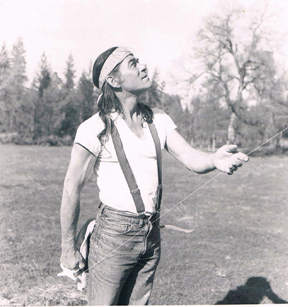|
| |
Born Peter Williams to the Turtle Clan of the Mohawk (Iroquois)
nation
on the Caughnawaga Reserve in
Kahnawake, Quebec, Canada, near the St. Lawrence River, in
the 1930s , he originally spoke only the Mohawk language before learning English
and French in grammar school on the Reserve and in Buffalo, New York. His
grandfather, a schoolteacher at Kahanwake, taught him both the plays of
Shakespeare and the tales of the Haudenosaunee /
Iroquois.
For much of his life Peter traveled and worked (as carpenter,
logger, ironworker, and woodcarver) in the American West. in his mid-twenties
Paiute elders gave him the name
Aroniawenrate, translated as
"Stepping across the Blue Sky" or "Climbing Up toward the Blue Sky," leading to
his renaming as Peter Blue Cloud, though he also wrote under the pen-names
Coyote 2,
Owl's Child, Turtle's Son, and Kaienwaktatsie. Living in northern California in
the 1950s exposed him to the Beat poetry and folk music movements, and in the
1960s and 70s he participated in and wrote about the Native American occupation
of Alcatraz Island in San Francisco Bay.
Among his publications of poetry, fiction, and dramar are
Turtle, Bear and Wolf
(1976), Back Then Tomorrow (1978). White Corn Sister (a play
for voices), The Paranoid Foothills (1981),
Elderberry Flute Song: Contemporary Coyote Tales (1982),
Sketches in Winter, with Crows (1984),
and The Other Side of Nowhere: Contemporary Coyote Tales (1990),
and Clans of Many Nations: Selected Poems, 1969-1994 (1995). (Along
with rabbits, coyotes and crows are
archetypal American Indian
trickster
figures.)
Later in life Blue Cloud returned to Mohawk territory,
where he wrote and edited for Akwesasne Notes, Coyote's Journal,
Indian Magazine, and other regional and tribal publications.
(Sources:
https://en.wikipedia.org/wiki/Peter_Blue_Cloud &
http://nativejewelrylit.com/native-writers-bluecloud.html)

Instructor's questions:
1.
How does this poem resemble the
Creation or Origin Stories in the
American Indian Creation Stories?
2. How does this origin story differ from Western Culture's
Origin
Stories of Genesis and
Evolution?
3. How does the poem represent a distinctly
American Indian story,
possibly of loss and
survival?
4. How does the poem indicate a
minority identity or voice?
5. How does "The Cry" work as a
lyric poem? What uses of
imagery,
metaphor,
symbols, sound, and other
literary devices?

The Cry
It was all darkness and
always had been.There was
nothing there forever.
Creation was a tiny seed
awaiting a dream.The
dream came to be
5because
of the cry.A howling cry
which wasan echo in the
emptiness of nothing.The
cry was very lonely and
caused the dream to
10turn
over in its sleep.The
dream did not want to awaken,
but the crying would not stop.
Well, thought the dream, opening its mind,
so now I am awake and there is something.
15
The dream floated above itself
and looked into its mind.
It wanted to see what the cry was.
What it saw was a dream
within its own dreaming.
20
[paradox]
And that other dream was Creation.
And Creation was the cry
seeking to begin something,
but it didn't know what,
and that is why it cried.
25
So the original dream lifted
the Creation dream from its mind
and set it free.
Then it went to the other end of nothing
and let itself go back
30
to dreamless sleep.
Creation floated all over the nothing,
dreaming of all the things it would do.
Its dreaming was interrupted
often by crying.
35
So, it wasn't me crying after all,
Creation thought.
Then it thought again,
but it is me because I dreamed it.
So, I have begun Creation with a cry.
40
When I begin to create the universe,
I must remember to give the cry
a very special place.
Perhaps
I'll call the cry
45
Coyote.
[allusion: coyote is a traditional American Indian
trickster figure often
associated with origin stories.]

From Peter Blue Cloud,
Back Then Tomorrow,
Blackberry, 1978; winner (1981) of an American Book Award from the Before
Columbus Foundation.
Peter Blue
Cloud (1935-2011) was a member of the Mohawk Nation at Akwesasne, a community
straddling the US-Canadian border at the St. Lawrence River.

|


